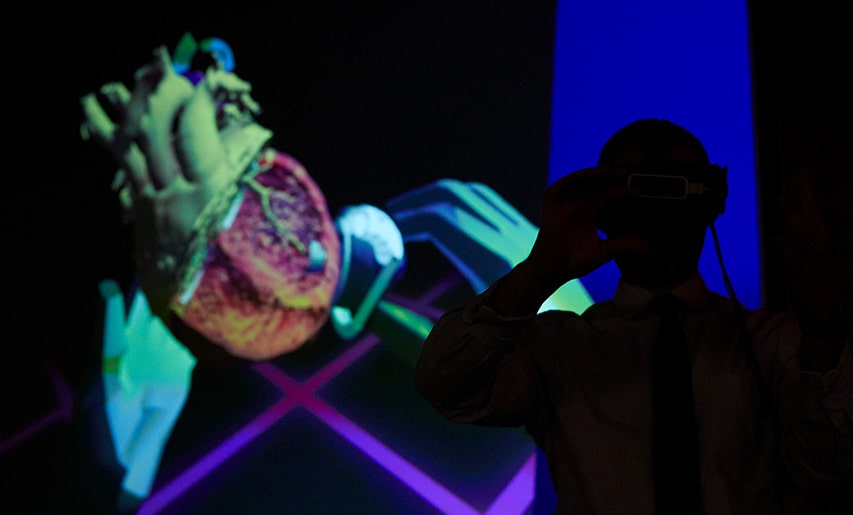
Using Virtual Reality to Engage Patients and Improve Outcomes
Twelve-year-old Brayden Otten took gaming to a new level when he slipped on a virtual reality headset last fall to “step into” his very own heart.
A team in the Heart Institute at Cincinnati Children’s has been leading the way in the use of virtual reality (VR) for planning complex cardiovascular procedures. Brayden’s heart surgery in December was one that benefited from this advanced technology.
Cardiothoracic surgeon David L.S. Morales, MD, and pediatric cardiologist Ryan A. Moore, MD, have been working together to hone their digital health skills for the past 10 years. They first began by taking images of patients’ hearts and converting them into 3D-printed models. More recently, they started taking those scans—more than 1,000 slices of imaging data—and putting them into 3D medical modeling software to create a digital anatomic twin, allowing them to engage with the models in a fully immersive VR environment. This gives the doctors a unique perspective in how they are able to look at and interact with the heart, opening up a new frontier in surgical planning.
“Using the VR space as the surgeon, I can take control and make the heart big enough that I can walk through it,” explains Morales, director of Congenital Heart Surgery with the Heart Institute. “I’m able to look at it from angles that aren’t possible during surgery, especially the back of the heart. The ability to plan and sequence the pathways I will create in a complex biventricular repair of the heart is a huge benefit.”
This past year, they’ve used the newly implemented VR platform on more than 20 complex cases and have logged nearly 200 virtual surgical planning cases over the past five years. The technology has allowed for biventricular repairs of certain hearts that were previously thought to be unable to be repaired or at least not in a single surgery. What previously would have been staged in two to three operations can now be done in just one thanks to the evolution of virtual planning.
Expanding Access to Patients and Families
This technology mirrors the capabilities of the video game and movie industry, and it’s backed by an in-house Digital Experience Technologies team that Moore says is on par with some of the industry leaders in terms of skill and quality.
“We have a unique team of developers and digital artists on staff in our Digital Experience Technologies Center who are incredibly talented,” says Moore, who is director of the program. “It’s challenging work, because we have to ensure that the models are 100% accurate while also being fully interactive and easy for medical providers to use.”
On top of that, they also want the models to be patient and family friendly. That’s where Brayden and his parents come in. Brayden previously had three surgeries as an infant to address complex congenital heart lesions associated with heterotaxy syndrome. In 2021, an MRI showed doctors he was a candidate for a more complex procedure to give him a fully functioning heart by rerouting pathways and enabling his second chamber to pump.
Not only could Morales use virtual reality to pre-plan the surgery step-by-step, but the team also used it to show Brayden and his parents exactly what would happen during his December surgery.
“I thought it was really cool because I could see how my heart works,” Brayden says. “At first I didn't know what was going to happen, but when I came in for the VR, I was able to understand more and it was a lot better.”
Brayden’s parents, Michelle and John, said their son’s attitude toward the operation changed once he had gone through the VR experience. After he interacted with his heart through virtual reality, he understood the surgical plan better and was highly motivated to have the operation.
Pushing the Limits of Digital Health Innovation
Another benefit of this technology is its multi-user experience. The ability to host multiple users has meant that the Cincinnati Children’s team has met in the virtual space with other institutions as close as Florida and as far away as Israel. In this way, they are able to help other surgeons plan out and practice surgeries to be performed at their own location. Cincinnati Children’s also uses the technology to train fellows and other staff.
The Digital Experience Technologies team continues to push the limits of digital health, partnering with big tech firms like Dell Technologies, NVIDIA and Microsoft to expand their capabilities with the goal of offering effective solutions to patients like Brayden.
For a long time, repairs like his were thought to be impossible. In fact, Brayden’s surgery was so successful that hospital recovery was a mere two weeks—much shorter than what the doctors had initially anticipated—and he was able to be home with his family in time for Christmas.
Moore is very hopeful for the future of VR technology in healthcare settings and expects a lot more to come. “I’m a test-the-limits-as-much-as-possible kind of person. I still think there’s a lot more we can do with this technology,” he said. “We see how video games and movies have evolved over the past 10 years, so this technology is constantly moving. A lot of what we’re going to be looking into is more interaction, more realism, and more connectivity. The opportunity is to continue to improve patient outcomes and to help kids better understand and be involved in their healthcare journeys.”
Funding for this project came from the State of Ohio, Ohio Development Services Agency, Ohio Third Frontier, Grant Control No. TECG2020-0252 and the Heart Institute, Cincinnati Children’s Hospital Medical Center. In addition, in 2021, Dell Technologies sponsored the opening of a Digital Experience Technologies lab within Cincinnati Children’s that now houses the VR research and development.